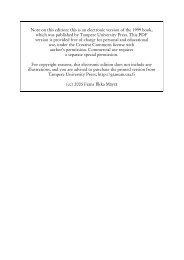Avaa tiedosto - TamPub - Tampereen yliopisto
Avaa tiedosto - TamPub - Tampereen yliopisto
Avaa tiedosto - TamPub - Tampereen yliopisto
Create successful ePaper yourself
Turn your PDF publications into a flip-book with our unique Google optimized e-Paper software.
ABSTRACT<br />
University of Tampere<br />
Faculty of Education<br />
Erja Katajamäki: MULTIPROFESSIONALITY AND HOW TO LEARN IT<br />
A Case Study at the University of Applied Sciences in the Field of<br />
Social and Health Care<br />
In this research the point of interest is multiprofessionality and how to learn it in the context<br />
of a multi-field university of applied sciences in the field of social and health care. The purpose<br />
of this research is to conceptualize multidisciplinarity and multiprofessionality as expertise<br />
in social and health care and find ways of learning it. The objectives are to increase the<br />
understanding of these phenomena and to find out factors in how to enhance learning in a<br />
multiprofessional way. The research questions are: how do the students’ and teachers’ experiences<br />
indicate multidisciplinarity and multiprofessionality and how do the students’ and<br />
teachers’ experiences indicate the students’ learning of multiprofessionality. The theoretical<br />
background lies on the theories of multidisciplinarity and multiprofessionality and also on<br />
collaborative learning as professional growth.<br />
The research approach is qualitative case study and the data has been analyzed using the content<br />
analysis method. The case studied is a learning project, which lasted one academic year.<br />
The main objective for the students was to learn multiprofessionality. The data consists of six<br />
students’ learning diaries, six teachers’ theme interviews, meeting materials and written<br />
project evaluations. Based on the analysis, there are 1,235 meaningful utterances from the<br />
total of 1,516 utterances. The results have been outlined as categories, which indicate the different<br />
dimensions of the phenomena in this research.<br />
The findings show that multidisciplinarity is the basis for multiprofessionality. It takes the<br />
form of administration, utilizing the sciences needed on the ground of the competence and of<br />
concrete work as multiprofessionality. The nature of the main concepts is both personal and<br />
communal. According to the results of the study, the question in multiprofessionality is in<br />
different experts in different fields who work together towards a common goal, the wellbeing<br />
of human beings’. Another result is that multidisciplinarity as a personal feature denotes the<br />
competence that multiprofessionality assumes. This kind of competence is described as skills














